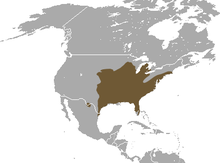| Eastern mole[1] | |
|---|---|

| |
| Scientific classification | |
| Domain: | Eukaryota |
| Kingdom: | Animalia |
| Phylum: | Chordata |
| Class: | Mammalia |
| Order: | Eulipotyphla |
| Family: | Talpidae |
| Genus: | Scalopus É. Geoffroy, 1803 |
| Species: | S. aquaticus
|
| Binomial name | |
| Scalopus aquaticus | |

| |
| Eastern mole range | |
| Synonyms | |


The eastern mole or common mole (Scalopus aquaticus) is a medium-sized North American mole. It is the only species in the genus Scalopus. It is found in forested and open areas with moist sandy soils in northern Mexico, the eastern United States and the southwestern corner of Ontario in Canada.
The eastern mole has grey-brown fur with silver-grey underparts, a pointed nose and a short tail. It is about 16 centimetres (6.3 in) in length including a 3 centimetres (1.2 in) long tail and weighs about 75 grams (2.6 oz). Its front paws are broad and spade-shaped, specialized for digging. It has 36 teeth. Its eyes are covered by fur and its ears are not visible.
The eastern mole spends most of its time underground, foraging in shallow burrows for earthworms, grubs, beetles, insect larvae and some plant matter. It is active year-round. It is mainly solitary except during mating in early spring. The female has a litter of two to five young in a deep burrow.
- ^ Hutterer, R. (2005). Wilson, D.E.; Reeder, D.M. (eds.). Mammal Species of the World: A Taxonomic and Geographic Reference (3rd ed.). Johns Hopkins University Press. pp. 301–302. ISBN 978-0-8018-8221-0. OCLC 62265494.
- ^ Matson, J.; Woodman, N.; Castro-Arellano, I.; de Grammont, P.C. (2017) [errata version of 2016 assessment]. "Scalopus aquaticus". IUCN Red List of Threatened Species. 2016: e.T41471A115188304. doi:10.2305/IUCN.UK.2016-3.RLTS.T41471A22319923.en. Retrieved 11 March 2022.
